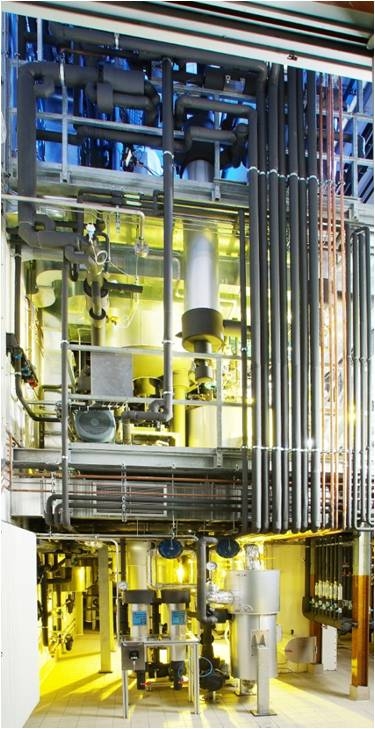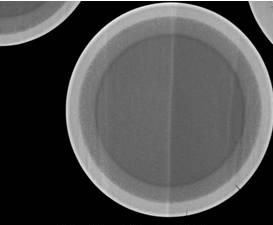The development and production of ceramic fibers is one of the main topics at Fraunhofer Center HTL. Ceramic fibers can be customized within wide limits. This concerns the composition, microstructure, fiber geometry and roving properties. Depending on the required fiber quantity, samples are produced on various spinning systems on a laboratory, pilot plant and pilot scale. If required, the fibers are also tested or further processed into textile semi-finished products.
Ceramic Fibers
Spinning compounds are produced at the HTL from metal-organic precursors or sol-gel precursors by adding spinning aids and adjusting the rheological properties. They are pressed through spinning plates, which are designed for monofilaments and rovings up to 500 filaments and allow different fiber diameters. The spinning towers available at the two locations in Würzburg and Bayreuth have a height of up to 4 m and allow both melt and dry spinning processes. The fibers are pyrolyzed and sintered after spinning. For the production of non-oxide fibers, the manufacturing process up to pyrolysis takes place completely in a high-purity inert gas atmosphere. Sintering is carried out in continuous furnaces, aligning the fibers. Subsequently, the fibers are sized and wound onto bobbins. The two production lines of the fiber pilot plant at the Bayreuth site can produce several tons of oxide and non-oxide ceramic fibers per year, respectively.
For oxide ceramic reinforcement fibers, the well-known material systems Al2O3, Al2O3-SiO2, Al2O3-Y2O3 and ZrO2 are used at HTL. Dopants e.g. with Ce, Fe, Mg or Y are used to control the grain growth. At the HTL, fibers with radial gradients of grain size are also developed to meet specific strength and creep requirements.
Non-oxide reinforcing fibers are made from SiC. Here, there is close cooperation with the company BJS Ceramics. In addition, a high-entropy fiber made of SiBNC was developed at the HTL, which has particularly good creep resistance at high temperatures due to its amorphous structure.
Fiber cross sections are usually round and lie in a range between 10 and 100 µm. Thicker fibers can be interesting for use in MMC, for example, because they have high kink resistance, while thinner fibers offer advantages in textile processing. Hollow fibers, e.g. for filtration purposes, or fibers with other cross-sections, e.g. kidney shape, can also be produced to enhance interfacial effects. In addition, other functional ceramic fibers are being developed besides hollow fibers, e.g. piezoelectric fibers. The number of fibers in the roving can be varied within wide limits. For example, rovings with only about 200 filaments can be produced for particularly thin-walled structures. For the production of woven fabrics, different roving types can be used in warp and weft direction in order to minimize the stresses caused by the ondulation by using different numbers of filaments or fiber diameters. Fiber design is supported at the HTL by simulation calculations.
Coating processes for ceramic fibers are being developed at the HTL. The task of the coating is to adjust a fiber-matrix interface that enables damage-tolerant behavior of ceramic composites. Another task is to protect the ceramic fiber from corrosive attack. When applying the fiber coating, a - comparatively inexpensive - novel wet-chemical route is followed. Process speeds of up to 1000 m/h are achieved. The HTL has experience in the application of non-oxide and oxide material systems. Multilayer systems of different ceramics can also be produced wet-chemically. Typical fiber coatings consist of silicon carbide, silicon nitride, boron nitride, zirconium oxide or spinel. The wet-chemically produced coatings are very suitable as sliding layers. Corrosion protection coatings, on the other hand, are limited because the thickness of the coatings is restricted to a few 100 nm. Thicker fiber coatings are produced by our cooperation partners using the CVD process. They can be combined well with the wet-chemical coatings.
Service Offering:
- Design of oxide and non-oxide ceramic fibers
- Dry and melt spinning technology in air and under inert conditions
- Sampling with special fibers up to 100 kg scale
- Development of hollow fibers (porous or dense) and two-component fibres
- Upscaling from laboratory up to pilot scale
- Process transfer to the customer including support in basic engineering
- Fiber characterization according to DIN EN standards
- Coating of ceramic fibers
 Fraunhofer ISC, Center for High Temperature Materials and Design HTL, Bayreuth
Fraunhofer ISC, Center for High Temperature Materials and Design HTL, Bayreuth



